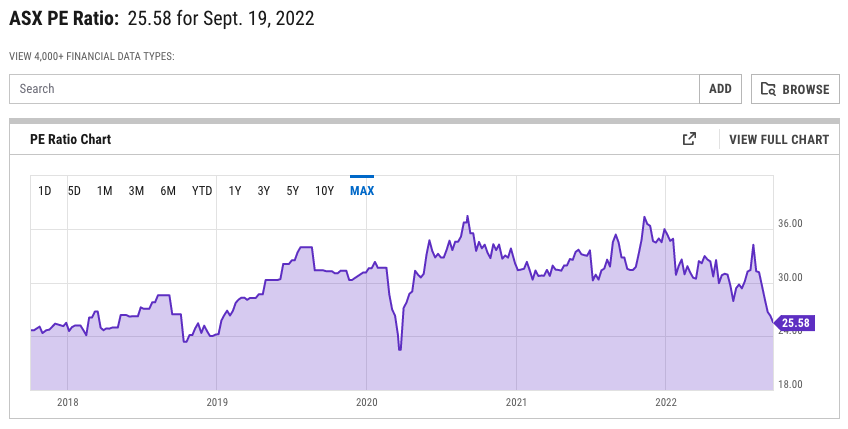- The S&P ASX 200 is down 10% from its April highs.
- As of the 19th of September, the ASX PE ratio is narrowing on the March 2020 lows, currently at a multiple of 25.58.
- What are some of the best value quality stocks on the market now?
Searching for value
Global stock markets have taken a bit of a beating of late. The Australian index of its 200 biggest companies by market capitalisation, the S&P ASX 200, is down 10% from the April highs.
The interest rate sensitive NASDAQ is down 27% from November last year. Adjusted for the impact of FX, the Japanese NIKKEI benchmark is also down 23% in US Dollar terms.
The sharp falls across the board might tempt some bargain hunters to dip their toes in the investment waters. What are some of the best value stocks right now in Australia?
Market heading into value territory
Top Australian Brokers
- Pepperstone - Trading education - Read our review
- IC Markets - Experienced and highly regulated - Read our review
- eToro - Social and copy trading platform - Read our review
The price-to-earnings (PE) ratio is one of the most widely used financial ratios. The PE ratio is calculated by taking the current price of a share and dividing it by the earnings per share.
The PE ratio is a valuable tool in assessing whether a company is over or undervalued as it ties the current market valuation to the reported earnings of the business.
One major caveat for the PE ratio is that the earnings inputted are historical, and the current market price is a forward-looking estimate. If a company is growing or shrinking quickly, then the PE ratio is not a reliable indicator of value.
Of the companies with a market capitalisation bigger than $5b AUD and a price-to-earnings multiple of less than 10, I don’t think it’s too surprising that the Australian names are predominately raw material producers. Are there other names we can add to the list of potentials?
Yancoal
Yancoal Australia Ltd ASX:YAL (YAL) is a coal miner that has recently benefitted from a buoyant coal market.
YAL currently trades at a very modest PE multiple of 3 and a generous forward dividend yield of 15.9%. With only a 1.5-year lifespan of the present highly prized thermal coal reserves, could the market be over-compensating for YAL’s reliance on coking coal for future revenues? The steel rebar market in China is still elevated and suggests there is present and future demand for its product.
A modest debt pile of $3.3b relative to the trailing twelve-month (TTM) gross profit of $7.4b points to a balance sheet able to divert some capital to shareholder returns and maintain the dividend. YAL is undoubtedly worthy of the consideration of the value investor.
Bluescope Steel Ltd ASX:BSL (BSL)
Further downstream from Yancoal but benefitting from the ready availability of coking coal and iron ore on the doorstep is BSL. A breakout revenue year in 2022 of over $18b and a healthy 43% gross margin have positioned Bluescope nicely with a 3% forward dividend yield. It is currently trading at a low 5.8 PE multiple.
The struggles in the property development sector from higher costs have taught the market to haircut the future earnings potential of BSL and leave the stock to trade around 16.37 per share on a net income of 2.8b this financial year. As the Australian economy ably navigates the global inflationary headwinds, there is still room for this critical building materials supplier to flourish.
Alternatives
Those looking for alternatives could do worse than considering Ampol Ltd, BHP Group Ltd, Fortescue and Rio Tinto. All are solid blue-chip names currently on sale right now.






